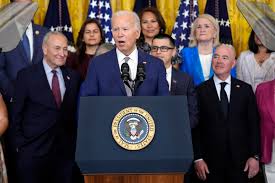
WASHINGTON— A new Biden administration policy announced Tuesday will give roughly half a million immigrants who are married to American citizens but lack legal status in the United States a pathway to citizenship for them and their children.
It is one of President Joe Biden’s most sweeping immigration policies and one that migrant advocates had been heavily lobbying the administration to undertake.
A look at the new policy, who might benefit and how:
How did things work before?
Under U.S. immigration law, if an American marries someone who is not a citizen but is living in the United States, it can be a straightforward process for the spouse to apply for long-term permanent residence — called a green card.
But if the spouse has been living in the United States illegally for a long time, that process gets much more complicated.
They often have to leave and apply from their home country. Depending on how long the person has lived in the U.S. without authorization, they could have to stay abroad for three to 10 years before applying to come back. They can seek a waiver to avoid waiting that long abroad, but getting a waiver also is averaging about three and a half years.
They have to go abroad, apply at a consulate — where waits can be extensive — and be permitted back into the U.S.
“There is the risk of prolonged separation especially if things go wrong,” said Elizabeth Taufa, policy attorney and strategist for the Immigrant Legal Resource Center.
Facing the prospect of leaving their families in America for a lengthy process that might not work, many decide to stay and live in the shadows.
How is Biden changing immigration policy?
Under the new policy, many spouses without legal status can now apply for lawful permanent residence without leaving the U.S. and eventually get a path to citizenship. But it’s not a blanket approval.
To be eligible, people have to have lived in the U.S. for at least 10 years, not pose a security threat and have been married by June 17, 2024. They would have to apply to the Department of Homeland Security, which considers the applications on a case-by-case basis, the department wrote in a fact sheet describing the new policy. Immigrant spouses cannot have already been admitted or paroled into the country previously.
Applicants will be vetted for previous immigration history, criminal history and more, including potential fraud, Biden’s announcement said.
Once Homeland Security approves an application, the White House said, the person would then have three years to apply for permanent residency and could get work authorization for up to three years.
About 1.1 million immigrants without legal status are married to American citizens in the United States, according to immigration advocacy organization FWD.us. The administration thinks that ultimately about half that number — about 500,000 — could be eligible for this program, plus about 50,000 of their children.
On average, the spouses have lived in the United States for a little over two decades, the White House said. A senior administration official said during a call to brief reporters that they expect the majority of people benefitting from the program will be from Mexico.
How does this fit in with Biden’s other immigration policies?
The Biden administration has pursued a two-pronged strategy on immigration and border security over the past year and a half.
On one hand, Biden has made it much more difficult to qualify for asylum at the southern border and intensified removals of those who don’t qualify to stay. Immigration advocates vilified Biden’s decision this month to cut off asylum processing after arrivals on the southern border hit a certain number per day.
On the other hand, the administration has taken a number of steps to admit people into the country.
In the biggest example, the administration created a program last year allowing people from Cuba, Haiti, Nicaragua and Venezuela to come to the U.S. if they have a financial sponsor, pass a background check and fly into a U.S. airport. As of the end of April, 434,800 people have arrived through that program from those four countries.
Many advocates have pushed the administration to do more for immigrants who have lived in the U.S. illegally for decades.
What’s changing in the program for ‘Dreamers’?
Separate from the policy for migrant spouses, the administration also announced changes designed to help those in the Deferred Action for Childhood Arrivals program qualify more easily for long-established work visas.
The Obama administration in 2012 offered people who were brought illegally to the U.S. by their parents as children deportation protections and temporary work permits. Many of them, often known as “Dreamers,” are now parents themselves.
Many companies who employ DACA recipients can apply for them to get a work visa, which is more stable and provides a pathway to permanent residence, said Dan Berger, an immigration fellow at Cornell Law School who co-founded Path2Papers, an organization that helps dreamers pursue work visas and other ways to get legal permanent residency.
But to get the work visa, the DACA recipient must travel abroad, apply and get a waiver to reenter the U.S. Berger said that waiver process is very slow and offers little guidance, so employers and DACA recipients aren’t eager to try it.
“Having clear guidance and clear expectation is really helpful,” he said.
What’s next?
The Department of Homeland Security has to produce guidance on how the spousal program will work. The program will go into effect by the end of summer, President Joe Biden said during a ceremony Tuesday.
It will fall to the U.S. Citizenship and Immigration Services, an agency within the Department of Homeland Security, to process all the applications. That agency has historically struggled with funding as it works to reduce backlogs and wait times.
Republicans and immigration opponents have intensely criticized the proposal, and opponents are almost certain to sue in an attempt to stop it.




